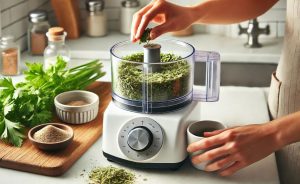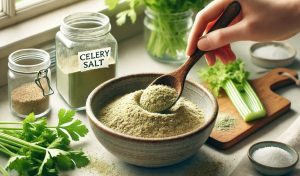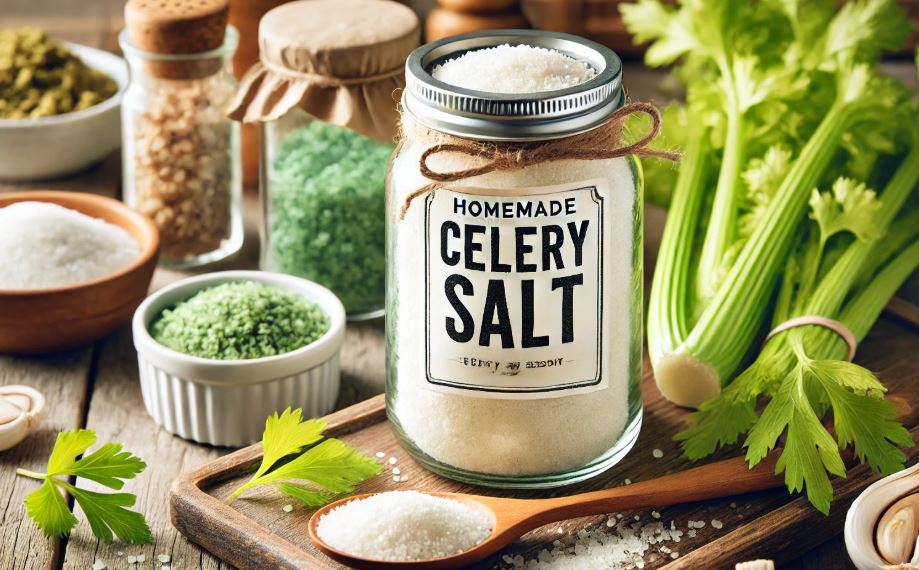Celery salt is a versatile seasoning made from ground celery seeds or leaves mixed with salt. Its aromatic, slightly peppery flavour enhances everything from classic
Bloody Mary cocktails to roasted vegetables. Making your own celery salt at home is surprisingly simple, allowing you to control the ingredients and freshness.
Whether you’re aiming to reduce waste with leftover celery leaves or create a unique spice blend, this homemade celery salt recipe is the perfect way to elevate your dishes.
What is Celery Salt?
Celery salt is a finely ground seasoning blend made primarily from dried celery seeds or celery leaves combined with salt. Its distinctive flavour is both earthy and slightly peppery, adding depth and aroma to various dishes.
Traditionally, celery salt is a staple in classic American recipes like Bloody Mary cocktails, Chicago-style hot dogs, coleslaw, and even popcorn. But its applications stretch far beyond these classics, making it an essential spice rack addition for any home cook.
The origin of celery salt dates back to the 19th century when it became popular as a medicinal spice due to celery’s anti-inflammatory properties. Over time, it evolved into a culinary favourite for its ability to elevate the flavour profile of dishes with just a pinch.
Celery salt is often compared to seasoned salts, but its unique aroma and taste set it apart. Unlike regular table salt, which is purely salty, celery salt adds a hint of bitterness and aromatic freshness, enhancing savoury dishes without overpowering them.
If you’ve only ever purchased celery salt from the store, you might be surprised by how easy and satisfying it is to make your own at home. By creating it from scratch, you control the quality of ingredients, avoid preservatives, and adjust the blend to suit your taste.
Why Make Your Own Celery Salt?
Store-bought celery salt is convenient, but making it at home has several distinct advantages:
- Freshness and Flavour Control: Homemade celery salt is far fresher than pre-packaged options, which often sit on store shelves for months.
- Quality Ingredients: You can choose high-quality sea salt and organic celery seeds or leaves for a more vibrant and natural taste.
- No Additives or Preservatives: Many commercial brands include anti-caking agents or preservatives. Making it at home eliminates unnecessary chemicals.
- Customization: You can adjust the salt-to-celery ratio based on your preferences and even experiment with smoked salt or flavoured varieties.
- Sustainable and Zero-Waste: If you grow your own celery or buy it fresh, you can use the leaves, often discarded, to make celery salt, reducing food waste.
Homemade celery salt not only enhances your culinary creations but also promotes a more sustainable and health-conscious kitchen. With just a few ingredients and simple steps, you can elevate the flavours of your dishes with a handcrafted touch.
Ingredients for Homemade Celery Salt
Below is a simple breakdown of what you need to create a delicious, homemade celery salt blend:
| Ingredient | Quantity | Notes |
| Celery Seeds | 2 tablespoons | Use fresh seeds for the best flavor. |
| Celery Leaves (dried) | 1 cup | Optional but adds a stronger celery taste. |
| Sea Salt or Kosher Salt | 4 tablespoons | Avoid iodized salt for a cleaner taste. |
Optional Additions
- Smoked sea salt for a smoky flavour
- Dried parsley or dill for a herby touch
- Black pepper for added spice
Whether you choose to use celery seeds or dried celery leaves, or a combination of both, the process remains simple and straightforward.
Both variations have their unique flavour profiles: celery seeds bring a concentrated taste, while dried leaves offer a fresher, herbal quality.
How to Make Celery Salt at Home? – Step-by-Step
Making celery salt at home is a simple process that requires minimal equipment and effort. Here’s a step-by-step guide:
Prepare the Celery

- If using celery leaves, wash and thoroughly dry them.
- Spread them out on a baking tray and dry in the oven at the lowest setting for 2-3 hours or until completely crisp.
Grind the Ingredients

- Add the dried celery leaves or seeds to a grinder or food processor.
- Pulse until they are finely ground.
Mix with Salt

- In a mixing bowl, combine the ground celery with the sea salt.
- Stir thoroughly to ensure even distribution.
Store Properly

- Transfer your celery salt to an airtight container.
- Store in a cool, dark place for up to 6 months for maximum freshness.
Label and Date
- Always label your jar with the date of preparation.
Making your own celery salt allows for adjustments to suit your taste, more celery for a stronger flavour, or less salt for reduced sodium intake.
Chef Variations of Celery Salt Recipes
Homemade celery salt allows for endless experimentation, and many chefs have crafted their own unique versions to enhance different dishes. Here are some well-known chef-inspired variations that bring out different flavours and textures:
Classic Celery Salt Recipe (Heidi Swanson’s Version)
Heidi Swanson’s version of celery salt is all about simplicity and bold flavour. This classic recipe combines high-quality celery seeds with flaked sea salt, resulting in a coarse texture that adds a satisfying crunch to dishes.
- Perfect for sprinkling over soft-boiled eggs for an extra layer of flavour.
- Ideal for seasoning fresh salad dressings, especially vinaigrettes.
- Adds a peppery, aromatic note to roasted vegetables and celery soups.
This version is as straightforward as it gets, pure, simple, and packed with natural flavour.
Zero-Waste Celery Leaf Salt (The Guardian Method)
The Guardian’s take on celery salt is rooted in sustainability. Instead of discarding celery leaves, this method emphasizes drying them out and blending them with sea salt to create a fresh, herbaceous seasoning.
- Promotes zero-waste cooking by using parts of the celery plant that are often thrown away.
- Offers a milder taste compared to celery seeds, making it perfect for light seasoning.
- Works wonderfully as a finishing salt for avocado toast, roasted vegetables, or grain bowls.
This recipe is ideal for those looking to minimize food waste while maximizing flavour.
Culinary Hill’s Spiced Celery Salt Blend
For those who love a bit of spice, Culinary Hill’s version is a must-try. This recipe enhances basic celery salt with ground black pepper and smoked paprika, adding layers of warmth and complexity.
- Ideal for Bloody Mary cocktails, giving them a bold, smoky kick.
- Enhances roasted vegetables like potatoes, carrots, and Brussels sprouts.
- Excellent for adding depth to grilled meats or marinating poultry.
This blend transforms celery salt from a simple seasoning to a multi-layered spice mix.
Smoky Celery Salt (Homesteading Family Method)
The Homesteading Family elevates celery salt by introducing smoked sea salt and toasted celery seeds. The result is a smoky, aromatic blend perfect for outdoor grilling.
- Adds a rich, smoky flavour to barbecue rubs for ribs and steaks.
- Great for seasoning roasted nuts or making savoury popcorn.
- Perfect for campfire cooking, enhancing both meats and vegetables.
This version is ideal for those who love the deep, bold flavours of smoked spices.
Herb-Infused Celery Salt (The Kitchn Inspiration)
The Kitchn brings an herbal twist to the traditional recipe by mixing celery salt with dried thyme and rosemary. This blend is aromatic and earthy, adding a touch of elegance to dishes.
- Perfect for seasoning roasted potatoes or grilled vegetables.
- Adds depth to stuffing and casseroles.
- Excellent as a finishing touch for focaccia or garlic bread.
The addition of herbs turns this celery salt into a versatile, all-purpose seasoning.
How to Store and Preserve Celery Salt Properly?
To maintain its freshness and potency, it’s important to store celery salt correctly. Proper storage extends its shelf life and preserves its flavour and aroma. Here’s how to do it right:
- Airtight Containers: Glass jars with tight-fitting lids work best to lock out moisture and air. Mason jars or spice containers with rubber seals are perfect choices.
- Cool, Dark Place: Store your celery salt in a pantry or cupboard away from direct sunlight and heat sources. Excessive heat or sunlight can degrade its flavour over time.
- Avoid Moisture: Make sure the container is completely dry before storing. Moisture causes clumping and can reduce its shelf life.
- Label and Date: Always label your jars with the date of preparation. This helps you track its freshness and ensures you use it before it loses its potency.
When stored properly, homemade celery salt can last up to 6 months without losing its vibrant flavour.
Creative Uses for Celery Salt in Cooking
Celery salt is far more versatile than just a Bloody Mary rim or a hot dog topping. Here are some delicious ways to incorporate it into your dishes:
- Sprinkle Over Roasted Vegetables: A light dusting of celery salt enhances the natural sweetness of roasted carrots, potatoes, and Brussels sprouts.
- Mix into Salads and Coleslaw: Adds an extra layer of flavour to creamy coleslaw, potato salads, and green salads.
- Season Meats and Poultry: Perfect for rubbing onto chicken, beef, or pork before roasting or grilling.
- Cocktail Essential: A must-have for Bloody Marys, Micheladas, and Caesar cocktails, where its herbal notes shine.
- Soup and Stew Enhancer: A pinch of celery salt in soups or stews deepens the flavour and adds a touch of aromatic warmth.
Celery salt’s unique flavour makes it a versatile addition to your spice cabinet.
Health Benefits and Nutritional Insights of Celery Salt
While celery salt is primarily used as a seasoning, it does offer some nutritional benefits, particularly if made from fresh, organic celery seeds or leaves. Below is the nutritional breakdown per teaspoon:
| Nutrient | Amount (per teaspoon) |
| Calories | 0 |
| Sodium | 400 mg |
| Potassium | 20 mg |
| Vitamin K | Trace amounts |
| Antioxidants | Present |
Key Health Benefits:
- Low-Calorie Seasoning: Perfect for adding flavour without additional calories.
- Rich in Antioxidants: Celery seeds contain antioxidants that may help reduce inflammation.
- Natural Diuretic: Celery is known to promote healthy fluid balance in the body.
- Supports Digestion: The herbal components in celery can aid in digestion and reduce bloating.
Moderation is key, as the sodium content is high. Using it mindfully in recipes brings out its healthful benefits without overloading on salt.
Common Mistakes to Avoid When Making Celery Salt
Even though the process of making celery salt is straightforward, there are a few common mistakes to watch out for:
- Using Moist Leaves: Always ensure that celery leaves are fully dried before blending. Moisture can cause mold and spoilage.
- Over-Grinding the Mixture: While fine grinding is preferred, over-processing can create a paste instead of a salt.
- Storing in Non-Airtight Containers: Exposure to air and moisture quickly reduces flavour and can cause clumping.
- Skipping the Label and Date: Forgetting to label your container can lead to stale salt if kept for too long.
- Neglecting to Toast Seeds (if using): Toasting celery seeds before grinding can amplify their flavour, so don’t skip this step.
Avoiding these common errors ensures that your celery salt remains fresh, aromatic, and ready to use whenever you need it.
Conclusion
Crafting your own celery salt not only enhances your culinary creations but also promotes sustainability and freshness in your kitchen. With just a few simple ingredients, you can create a versatile seasoning that outshines store-bought options.
Try experimenting with chef-inspired variations to discover new flavours, and enjoy the satisfaction of homemade goodness with every sprinkle. Store it well, use it creatively, and let celery salt become your secret ingredient.
Frequently Asked Questions About Celery Salt
Can I use fresh celery instead of dried leaves or seeds?
No, fresh celery has too much moisture and will not blend well with salt.
How long does homemade celery salt last?
Properly stored, it remains fresh for about 6 months.
Is celery salt gluten-free?
Yes, as long as your salt and celery seeds are uncontaminated.
What can I substitute for celery salt?
Dried celery flakes or celery seed powder combined with salt.
Can I use iodized salt?
It’s best to use sea salt or kosher salt for a cleaner flavour.

Celery Salt Recipe
Ingredients
- 2 tbsp Celery Seeds Use fresh seeds for the best flavor.
- 1 cup Celery Leaves Optional but adds a stronger celery taste.
- 4 tbsp Sea Salt or Kosher Salt Avoid iodized salt for a cleaner taste.
Instructions
- If using celery leaves, wash and thoroughly dry them.
- Spread them out on a baking tray and dry in the oven at the lowest setting for 2-3 hours or until completely crisp.
- Add the dried celery leaves or seeds to a grinder or food processor.1 cup Celery Leaves, 2 tbsp Celery Seeds
- Pulse until they are finely ground.
- In a mixing bowl, combine the ground celery with the sea salt.4 tbsp Sea Salt or Kosher Salt
- Stir thoroughly to ensure even distribution.
- Transfer your celery salt to an airtight container.
- Store in a cool, dark place for up to 6 months for maximum freshness.
- Always label your jar with the date of preparation.









